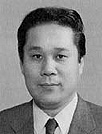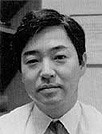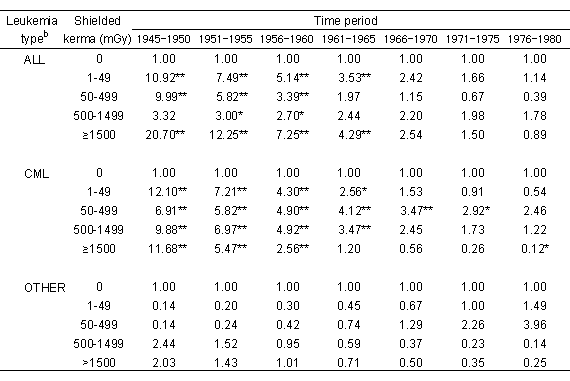A-bomb Irradiation and Leukemia Types: An Update
A recent reclassification of leukemia cases among atomic bomb survivors demonstrates that the effects of radiation exposure differ depending on leukemia type.
by Masao Tomonaga and Tatsuki Matsuo, Department of Hematology, Atomic Disease Institute, Nagasaki University School of Medicine, and Randolph L Carter, RERF Department of Statistics
This article was originally published in RERF Update 3(4):5-6, 1991.
Recent advances in hematology and molecular biology have consistently established that spontaneously occurring (de novo) leukemias consist of 4 major types: acute myeloid leukemia (AML), acute lymphoid leukemia (ALL), chronic myeloid leukemia (CML), and chronic lymphocytic leukemia (CLL). It is now apparent that they occur through distinct genetic abnormalities including oncogenes in the differentiation process of hematopoietic stem cells.



The authors, from left: Tomonaga, Matsuo, and Carter.
During the last 4 decades, extensive studies carried out at ABCC-RERF and other institutions have established that A-bomb irradiation did induce excess cases of leukemia–in particular, acute leukemia and CML. In the early postbombing period, the leukemogenic effects of A-bomb irradiation were apparently greater in individuals exposed at younger ages, and they declined more rapidly in subsequent years. Among those who were older at the time of bombings (ATB), the effects appeared later and persisted longer.
Most of the earlier studies concentrated on acute leukemia and CML, based on case ascertainment using the diagnostic methods of the early 1960s and the T65D dose estimates. The number of leukemia cases in the 120,000-member Life Span Study (LSS) cohort was insufficient to analyze the effects of radiation exposure on finely categorized leukemia types. Neither did the older diagnostic methods distinguish between AML and ALL from the present immunological point of view, thus rendering extensive study of each subtype very difficult. More recently, however, the widespread adoption of the French-American-British classification system does provide the morphological and cytochemical criteria for distinguishing between AML and ALL, and these have proved highly efficient in subsequent immunological marker analyses.
Since the early studies were conducted, new leukemia entities have been identified such as adult T-cell leukemia (ATL). Induced by the HTLV-1 virus, ATL is endemic to the island of Kyushu where Nagasaki City is located.
Reclassification of leukemia cases among the A-bomb survivors
Leukemia cases can now be classified into 21 categories. Since the size of the LSS cohort does not allow such fine distinctions, we supplemented the LSS data with additional cases from the entire cohort of A-bomb survivors, referred to here as the “open city” sample. Through 1980, 766 cases were registered at ABCC-RERF among survivors who were within 9 km of the hypocenter ATB. Of these, 493 (177 LSS cases) were reclassified based on adequate hematological and pathological preparations, and 413 (157 LSS cases) of these had been assigned DS86 estimates. After carefully checking for possible selection biases, we used these 413 cases to estimate the proportions of ALL, AML, CML, and other types of leukemia (here referred to as “OTHER”) as functions of DS86 estimate, age ATB, city, and time since exposure. Then the estimated proportions were used to calculate the ratios of relative risks (RRR) in order to compare the effects of kerma, age ATB, city, and time since exposure on the incidence of ALL, CML, and OTHER relative to those effects on AML incidence. The AML category was chosen as the reference type because it is the most prevalent of all leukemias. Such RRRs provided a method for statistical analysis of differential effects of irradiation on major leukemia types, thus allowing use of supplemental cases from the open city population of survivors. (The full technical report by M Tomonaga et al, RERF TR 9-91, has been published.)
New information
Incidence rates of all 4 leukemia types increased with kerma. The effects of radiation exposure on incidence were significantly greater for ALL and CML than for AML and OTHER (see Table). Kerma values less than 50 mGy and probably as low as 16 mGy apparently produced excess cases of ALL and CML (see Table), whereas kerma values greater than 50 mGy and probably at least 229 mGy were required to produce excesses in AML. These differential effects disappeared in time as ALL and CML incidence rates returned to background levels.
In the 2 lowest kerma categories (1-49 and 50-499 mGy), the estimated incidence either remained constant or increased slightly as the population of survivors aged. However, in the 2 highest categories (500-1499 mGy, and greater than or equal to 1500 mGy), the estimated incidence rates of all types among those who were less than 16 years old ATB declined with elapsed time since exposure. ALL and CML incidence declined similarly among those exposed as adults, whereas the incidence of AML either remained constant or increased with time. An excess of AML and ALL, but not CML and OTHER, remained through the final study period (1976-80) in the greater than or equal to 1500-mGy category (see Table).

Table. Ratios of relative risksa for comparing radiation exposure effects on acute lymphoid, chronic myeloid, and other leukemia types to corresponding effects on acute myeloid leukemia.
aRisk of leukemia types at given kerma levels, relative to the risk in the nonexposed, divided by the corresponding relative risk of acute myeloid leukemia. Relative risk ratios greater than 1.0 suggest a greater radiogenic effect on the given leukemia than on AML; ratios less than 1.0 suggest a greater effect of the given level of radiation on AML risk.
bAcute lymphoid leukemia (ALL); chronic myeloid leukemia (CML); amd other leukemia types, including adult T-cell leukemia, as well as other specifically diagnosed leukemias (OTHER).
*Relative risk ratios significantly different from 1.0 at the 0.10 level of significance.
**Relative risk ratios significantly different from 1.0 at the 0.05 level of significance.
Time to onset of ALL, AML, and CML decreased as kerma increased. The rate of decline, however, was greater for ALL and CML than for AML. The resulting differences at high values of kerma reflect shorter incubation times for A-bomb-induced ALL and CML than for AML. When controlling for leukemia type, the time to onset of leukemia was not significantly affected by age ATB.
Among unexposed individuals, the estimated risk of CML for Nagasaki relative to Hiroshima was significantly less than that of AML, whereas that of OTHER types was significantly greater because ATL cases occurred only in Nagasaki. City effects on background rates appeared to explain a generally higher incidence (except for ATL) in Hiroshima than in Nagasaki.
Thus, the analysis of recently reclassified leukemia cases from the LSS and additionally from the open city population revealed several important findings:
- A-bomb radiation exposure affected the induction of the major leukemia types in different ways. ALL and CML were induced earlier and at lower doses compared with AML, suggesting greater effects of A-bomb irradiation on ALL and CML incidence.
- An excess of both AML and ALL remained through 1980.
- The generally higher incidence of non-ATL leukemias observed among exposed individuals in Hiroshima compared with Nagasaki may simply be an extension of proportionately different background rates of leukemia.
- The previous results concerning the relationship between age ATB and time to onset of leukemia could not be confirmed in this study. Independent of leukemia type, age ATB was not significantly related to the time to onset of leukemia.
- The reclassification task revealed that the morphological picture for A-bomb-induced leukemias is indistinguishable from that of de novo human leukemias.
These findings provide us with some insights for understanding radiation-induced leukemogenesis as well as de novo leukemogenesis. Age distributions are known to be distinct between different types of de novo leukemia. These distinctions were also observed in A-bomb-related leukemias. A-bomb irradiation may have induced leukemia by accelerating de novo leukemogenesis in a subpopulation of survivors prone to develop leukemias.

